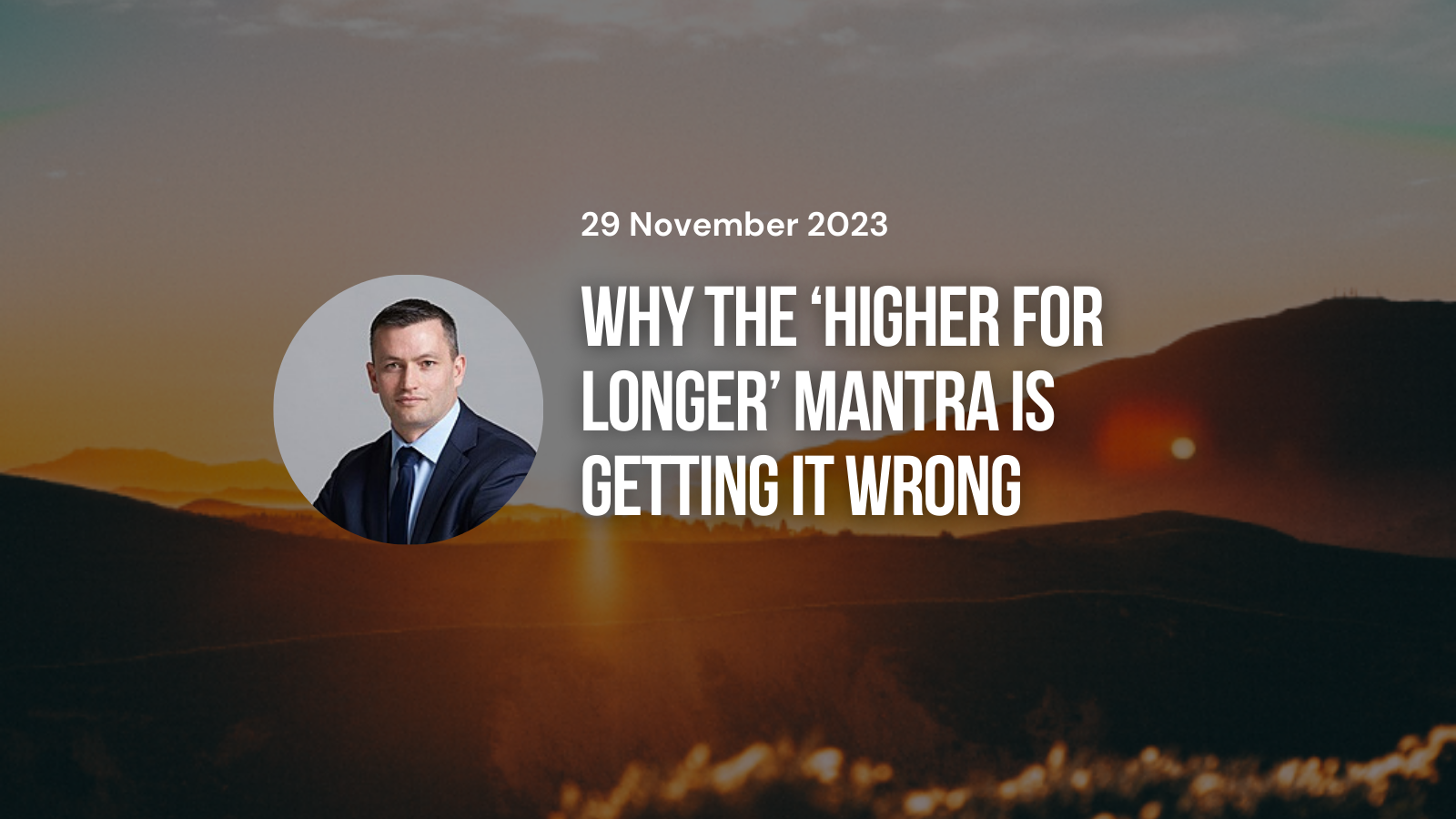
By Matthew Haupt, Wilson Asset Management
29 November 2023
Markets have been captured by the US Federal Reserve’s ‘higher for longer’ mantra.
But what most are missing is a serious deterioration in forward looking economic data.
Contrary to ‘higher for longer’, we anticipate that a more probable scenario for the coming year will be a sequence of rate reductions, potentially by as much as 50 basis points in Australia and up to 200 basis points in the US.
Despite the current widespread pessimism about the cost of living, we do not expect this phase of transient inflation to withstand the test of time.
And as the pressure of higher rates recedes, markets are poised for a robust rally in the new year.
Forward looking data signalling downturn
Most of the headlines in the media currently are about big economic numbers like the consumer price index (CPI), the unemployment rate and gross domestic product (GDP) growth. And mostly, they are all holding strong.
But what can be missed is that these are largely backwards-looking statistics that tell you the state of the economy last month, or even last quarter.
Less talked about are the forward-looking indicators — and mostly they are all pointing to a downturn.
Monthly surveys of businesses are showing signs that activity is softening. Measures of the prices companies pay for their inputs are falling. Industrial production globally is soft. A survey of credit conditions in the US shows lending has tightened.
These are all leading indicators.
And they all add up to a raft of data that shows we do not need to be in this high interest rate environment for very much longer.
Markets expect rates to stay high
Despite all this evidence, the markets expect interest rates to stay high.
Market expectations can be gauged by the prices that investors are paying for bonds of differing maturity dates.
This ‘forward curve’ of interest rates shows Australian investors see rates holding at their highs throughout next year, while US investors have only recently shifted expectations to price in about 100 basis points of cuts. We think this is wide of the mark.
WAM Leaders (ASX: WLE) expects Australian rates to fall by around 50 basis points next year — taking the Reserve Bank of Australia (RBA) cash rate back below 4% — while in the US, a fall of as much as 200 basis points could be on the cards.
Interest rates drive stock markets
Now, lower rates are not always good news — a large cohort of Australians live off the interest and dividends from their investments and, for them, lower rates means less cash in hand.
But rate cuts do have a powerfully positive effect on stock markets.
There are two main drivers of share prices — the earnings that companies generate and the price that investors are willing to pay for those earnings, measured by the price to earnings, or PE, ratio.
As the economy deteriorates, corporate earnings tend to fall.
However, the reverse is true for PE ratios, which tend to rise as interest rates fall and more than offset any earnings decline.
The reason PE ratios rise is that the level of interest rates directly affects the current value of a company’s future earnings. Lower rates mean tomorrow’s earnings are worth more to an investor today.
Next year’s earnings slowdown is likely to come in around 10 to 15%, slightly better than the 30% declines of previous downturns because the past few years have not seen a build-up of excess.
But offsetting that earnings decline will be a potential lift in PE ratios from 15 to as much 20 times earnings, significantly boosting stock markets.
Next year’s winners
Share markets rise in a falling interest rate environment, but some sectors tend to perform better than others.
Share prices for utilities often rise as their high dividend yields become more attractive to investors seeking income. Infrastructure companies benefit from lower borrowing costs.
The technology sector tends to gain momentum as fast-growing tech stocks are often sought after for their future earnings, which are more valuable when rates are lower.
And homebuilding and real estate stocks typically see a boost as lower mortgage rates fire up the housing market.
On the downside, the banks tend to underperform as lending margins get squeezed.
Second order effects
Lower rates also trigger second order effects that are positive for markets but often overlooked.
This is because lower rates typically mean a weaker US dollar. That sparks demand for commodities, which are typically priced in US dollars, leading to a rally in companies exposed to energy, materials and gold.
A lower US dollar also tends to correlate with higher appetite for risk assets and easing financial conditions across the world, which acts a catalyst to send stocks higher.
Lower rates also see private equity and hedge funds return to the market, lift the rate of corporate merger and acquisition activity, and encourage more new companies to float.
Markets can rally quickly
Remember that markets look forward, but the headline economic statistics look backwards.
If the economy enters a recession in the fourth quarter of this year, the official statistics will not reflect that until November of next year.
But stocks will have started running well before then.
Homebuilder stocks tend to start rising at the start of a recession; consumer discretionary stocks start running before the downturn is halfway through.
The stock market is always looking forward and investors price companies based on expectations of their future earnings.
Positive signs ahead
Around inflection points in markets there is always peak hysteria.
But the idea that inflation and interest rates will stay ‘higher for longer’ is almost comical at the moment.
The data is building for interest rate cuts. Every cycle goes through a rate cutting phase and even if the next moves in rates are higher, that just accelerates progress to the cutting.
Central banks are in a dilemma — they can see economic conditions slowing down but they have to be hawkish right to the end to avoid triggering a rebound in inflation.
This is an interesting time for markets — the banks clearly don’t believe what they are saying, but they have to pretend to keep financial markets tight.
But there is no need for investors to get caught up in that game. Find more about Wilson Asset Management here.






